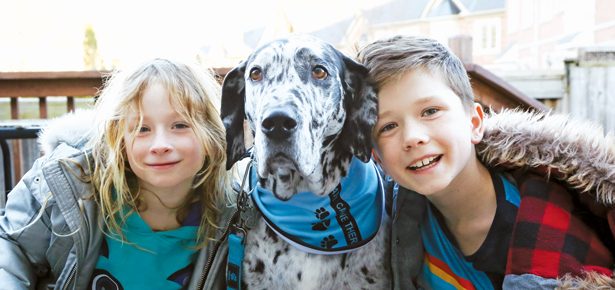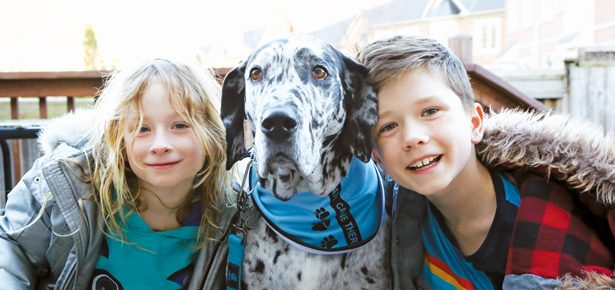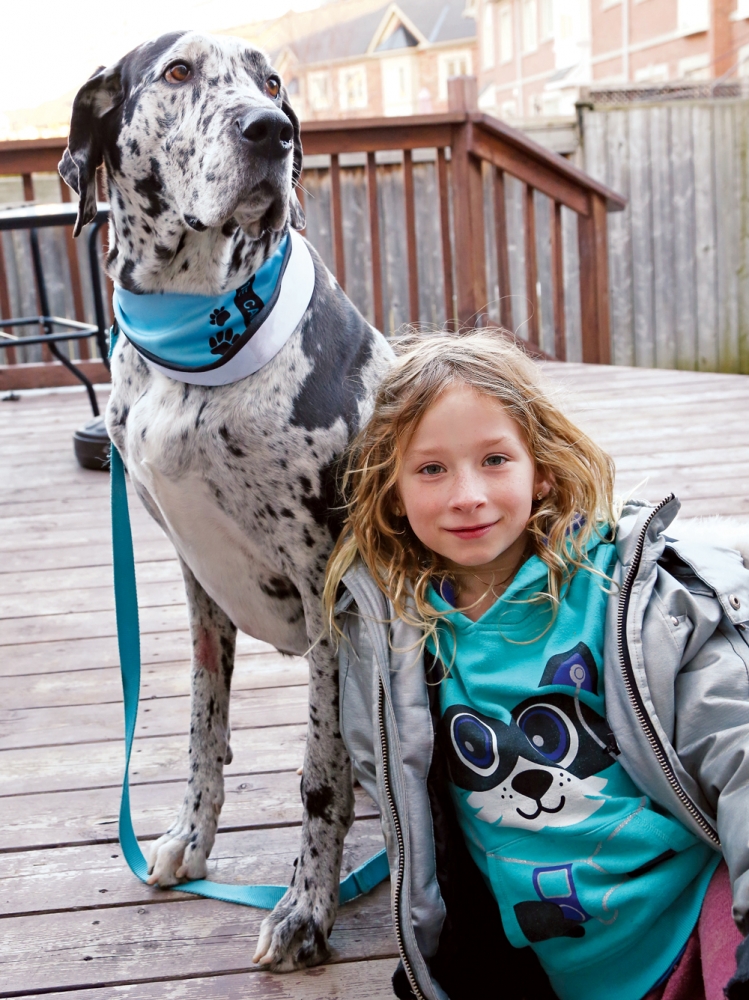

The Therapist Has Four Legs
Therapy dogs are making a world of difference in settings both corporate and private.
Before Rodney Kaufman hit his mid-twenties, life was going according to plan. He had been studying to become a chef at top-notch Cordon Bleu culinary schools in London and Paris. Upon returning to Toronto, Ontario, he worked at a couple of high-end restaurants before opening a fine dining establishment, Avant Garde Bistro and Wine Bar, in the Yorkville area of Toronto.
His ambitions were finally meeting reality until anxiety crept onto his “to do” list. At first, he ignored the feeling of doom that often accompanies anxiety. He ignored the chest pain, headaches, neck tension, shortness of breath, heart palpitations, and insomnia. However, as time passed his anxiety turned into full blown panic attacks. Initially he thought he was having a heart attack, but the doctors declared there was nothing physically wrong with him. Whatever he did, whatever he tried, nothing stopped the waves of panic that were destroying his life.
Eventually, Rodney sought psychiatric help, and with intense cognitive behavioural therapy and medication, the world again seemed like a safe place—until he began slowly tapering off the medication. The panic attacks that had disappeared reappeared. The intense sweats and feelings of impending disaster returned. It was then that Rodney happened upon an article about therapy dogs and how they could significantly change the life of someone trying to cope with tremendous anxiety. The article made a lasting impression—fast forward 20 years, and Rodney decided to adopt an eight-week-old puppy Great Dane named Harlow and, enlisting the help of a dog trainer, taught Harlow to become a therapy dog.
Therapy dogs are trained to provide comfort and affection, calming and grounding people suffering from anxiety disorders, autism, and other mental and physical disorders. Learn what the best therapy dog breeds are.
Rodney believes dogs have an empathetic side and almost a sixth-sense. “They know and understand how people are feeling,” he says.
After seeing first hand how the Great Dane changed his life, Rodney became a dog trainer and handler and started a Toronto-based dog therapy business called Corporate Canine Therapy (CCT). Rodney and his team specialize in workplace stress reduction via visits from their trained, uniformed therapy dogs and handlers. They also offer their services to individuals and facilities.
“Dogs lower stress levels,” says Rodney, who also has more than four years volunteer experience and received a Children's Hospital Volunteer Service Excellence Award for Therapy Dogs in 2018. “I have been privileged to witness the extraordinary bond children can forge with our dogs. The unconditional companionship, calming effects, and easing of anxiety during certain procedures have proven effective. One notable relationship I saw had a very young infant—irritable and fussy while undergoing painful chemotherapy procedures—become noticeably and almost instantaneously relaxed and quiet when placed in the arms of our Great Dane Therapy Dog.”
CCT has targeted both the corporate and private marketplaces, as it has seen a growing need for this kind of therapeutic approach to wellness in both areas. In the workplace environment, contemporary human resource departments seem to understand the benefits to their employees and are eager to take advantage of CCT’s services to promote overall stress relief. Rodney says the benefits of CCT in the work place are multifold, including “reduced stressed levels, boosted workplace productivity, improved happiness, and better teamwork.”
In the private sector, CCT has seen a continued demand for visits to individuals living in seniors’ homes, long-term care facilities, and even private homes. At the present time, CCT visits six families with children who experience anxiety issues, ADHD, and/or have physical disabilities.
Both my own kids have been diagnosed with ADHD, so I was particularly interested in the home visits and how they can help. As parents of children with ADHD will attest, the disorder is challenging. The primary features of attention-deficit/hyperactivity disorder include inattention and hyperactive-impulsive behaviour. Symptoms can be mild, moderate, or severe, and they may continue into adulthood. The Mayo Clinic notes that ADHD “can be difficult for children and their parents who are trying to cope with their afflicted child. Children with ADHD often struggle in the classroom, which can lead to academic failure and being judged negatively by other children and adults. They tend to have poor self-esteem, are more likely to have trouble interacting with and being accepted by peers and adults, and are at increased risk of alcohol and drug abuse and other delinquent behaviour as they get older.”
Since both my kids, Nathan and Elle, suffer from different degrees of ADHD, I decided to confer with Rodney to see if his dogs could help, as well as dig deeper into the research on therapy dogs and ADHD.
What I discovered was fascinating. In randomized trials, researchers from the University of California Irvine found that therapy dogs decreased symptoms of attention deficit/hyperactivity disorder in children.
“One notable relationship I saw had a very young infant—irritable and fussy while undergoing painful chemotherapy procedures—become noticeably and almost instantaneously relaxed and quiet when placed in the arms of our Great Dane Therapy Dog.”
Led by Sabrina E. B. Schuck, PhD, MA, the trial established that children with ADHD who received canine-assisted intervention experienced a reduction in inattention, an improvement in social skills, and fewer behavioural problems.
The trial—titled “A Randomized Controlled Trial of Traditional Psychosocial and Canine-Assisted Interventions for Children with ADHD”—involved 88 children from seven to nine years old who had been diagnosed with ADHD and who had no previous exposure to medication.
The study provided solid evidence supporting the use of therapy dogs in conjunction with traditional psychosocial therapy for children with ADHD.
Based on my findings and Rodney’s experiences, I asked him to visit and spend some time with my children.
Before Rodney arrived at the house, my daughter was playing the piano and singing/screaming “Wake Me up Before You Go Go” by the 80’s group “Wham!” while my son was caught up in an intense argument with his mother about the due date on his homework.
When the doorbell rang my daughter jumped over the couch to unlock the door. Rodney and Harlow stood in the doorway. My son stopped arguing as Rodney introduced himself and Harlow to my kids. Both of them were flabbergasted by the immense size of Harlow. Rodney shared with the children that Harlow has helped hundreds of children with physical and mental issues. My kids, who are normally somewhere between wild and frantic, were inexplicably calmed simply by Harlow’s presence. It was as if the giant dog was some sage Jedi warrior, freakishly strong with the force. The focus my daughter displayed when Rodney pointed out photos of other therapy dogs on the iPad was amazing. Rodney later commented, “You noticed how when I was onsite, I was using the dog to keep the kids focused for 10 to 15 minutes? They were not distracted or hyper and therefore they were able to learn about the dog and ask good questions without losing focus.”
Afterwards Rodney suggested my daughter read to Harlow. I explained to Rodney that Elle would rather be electrocuted than read. Ignoring my warning, Rodney handed Elle a book—which she read non-stop for almost ten minutes while patting Harlow. Usually when Elle catches the slightest glimpse of a book she bolts for the nearest exit. And if she does decide to cooperate and “read,” her normal way is to lie upside down and attempt to read without actually looking at the words. But with Harlow, Elle was a completely different girl. She seemed fixated on correctly pronouncing the words and was interested in understanding the story. Rodney reflected, “Harlow is also what is called a reading dog and that simply means she will sit for an hour or so while kids who may be too shy or have trouble reading can read to her without feeling anxious or judged.”
According to Therapeutic Paws of Canada, “Studies have shown that reading to dogs encourages confidence and boosts self-esteem in children who struggle to read aloud in class, therefore boosting their literacy.”
Rodney then worked with my son Nathan, teaching him how to use voice commands to get Harlow to sit, roll over, and stand. “It's not about the strict tone as much as it is a confident voice,” Rodney explained to me. “When the dog obeys the command, the child feels a sense of pride and accomplishment. They stay focused on the dog and we find their attention lasts a lot longer with a dog by their side.”
After Rodney’s personal testimony and Harlow’s visit with my kids, I’ve become a major believer in the good that therapy dogs can do for people suffering from various types of physical and mental disorders. My wife and I are already discussing adopting a therapy dog for our children.
Related Reading:
Emotional Support Animals vs. Service Dogs, What's the difference?
Join the newsletter and never miss out on dog content again!
"*" indicates required fields
By clicking the arrow, you agree to our web Terms of Use and Privacy & Cookie Policy. Easy unsubscribe links are provided in every email.

